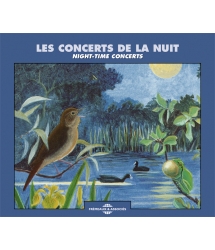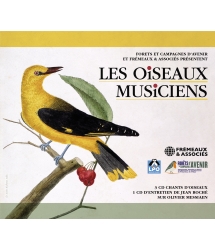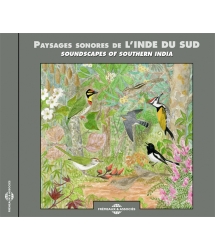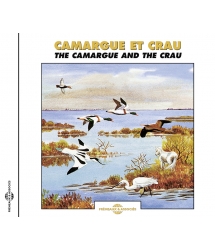- Our Catalog
- Philosophy
- Philosophers of the 20th century and today
- History of Philosophy (PUF)
- Counter-History and Brief Encyclopedia by Michel Onfray
- The philosophical work explained by Luc Ferry
- Ancient thought
- Thinkers of yesterday as seen by the philosophers of today
- Historical philosophical texts interpreted by great actors
- History
- Books (in French)
- Social science
- Historical words
- Audiobooks & Literature
- Our Catalog
- Jazz
- Blues
- Rock - Country - Cajun
- French song
- World music
- Africa
- France
- Québec / Canada
- Hawaï
- West Indies
- Caribbean
- Cuba & Afro-cubain
- Mexico
- South America
- Tango
- Brazil
- Tzigane / Gypsy
- Fado / Portugal
- Flamenco / Spain
- Yiddish / Israel
- China
- Tibet / Nepal
- Asia
- Indian Ocean / Madagascar
- Japan
- Indonesia
- Oceania
- India
- Bangladesh
- USSR / Communist songs
- World music / Miscellaneous
- Classical music
- Composers - Movie Soundtracks
- Sounds of nature
- Our Catalog
- Youth
- Philosophy
- News
- How to order ?
- Receive the catalog
- Manifesto
- Dictionnary











- Our Catalog
- Philosophy
- Philosophers of the 20th century and today
- History of Philosophy (PUF)
- Counter-History and Brief Encyclopedia by Michel Onfray
- The philosophical work explained by Luc Ferry
- Ancient thought
- Thinkers of yesterday as seen by the philosophers of today
- Historical philosophical texts interpreted by great actors
- History
- Books (in French)
- Social science
- Historical words
- Audiobooks & Literature
- Our Catalog
- Jazz
- Blues
- Rock - Country - Cajun
- French song
- World music
- Africa
- France
- Québec / Canada
- Hawaï
- West Indies
- Caribbean
- Cuba & Afro-cubain
- Mexico
- South America
- Tango
- Brazil
- Tzigane / Gypsy
- Fado / Portugal
- Flamenco / Spain
- Yiddish / Israel
- China
- Tibet / Nepal
- Asia
- Indian Ocean / Madagascar
- Japan
- Indonesia
- Oceania
- India
- Bangladesh
- USSR / Communist songs
- World music / Miscellaneous
- Classical music
- Composers - Movie Soundtracks
- Sounds of nature
- Our Catalog
- Youth
- Philosophy
- News
- How to order ?
- Receive the catalog
- Manifesto
- Dictionnary
KENYA - AN ILLUSTRATED ORNITHOLOGICAL EXPEDITION
JEAN CLAUDE ROCHE
Ref.: FA681
Artistic Direction : JEAN ROCHE
Label : Frémeaux & Associés
Total duration of the pack : 50 minutes
Nbre. CD : 1
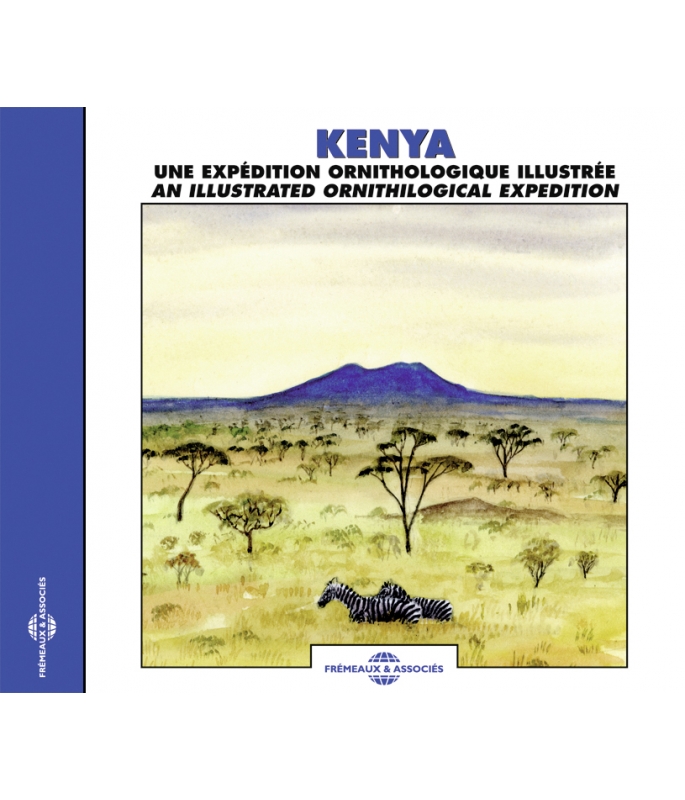
KENYA - AN ILLUSTRATED ORNITHOLOGICAL EXPEDITION
KENYA - AN ILLUSTRATED ORNITHOLOGICAL EXPEDITION
Including a 24 page colour booklet featuring Serge Nicolle's watercolour pictures, this previously unreleased Jean-Claude Roché production invites the listener on a real ornithological expedition to Kenya. There are nine natural concerts with a total playing time of more than 50 minutes and the colour booklet allowing the identification of each species. A true acoustic safari on CD. Patrick Frémeaux
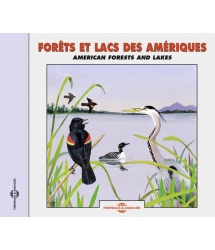
AMERICAN FORESTS AND LAKES
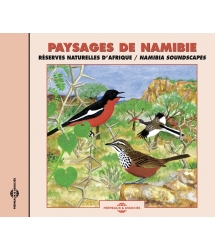
NAMIBIA SOUNDSCAPES
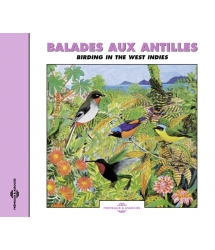
BIRDING IN THE WEST-INDIES
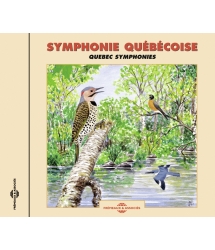
QUEBEC SYMPHONIES





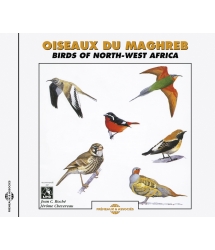
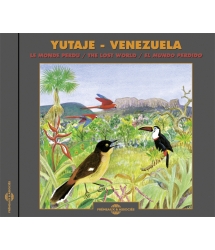
-
PisteTitleMain artistAutorDurationRegistered in
-
1Mackinon RoadMackinon Road00:05:032009
-
2Au bord du lac Nakuru (Début)On the shores of Lake Nakuru (Start)00:07:022009
-
3Au bord du Lac Nakuru (Suite)On the shores of Lake Nakuru (Follow-up)00:06:042009
-
4Jardin du Museum de NairobiNairobi Museum garden00:03:192009
-
5BushwakersBushwakers00:05:222009
-
6Parc National TsavoTsavo national park00:05:032009
-
7KwaleKwale00:05:232009
-
8KitaleKitale00:05:192009
-
9MombassaMombassa00:07:302009
KENYA
KENYA
UNE EXPÉDITION ORNITHOLOGIQUE ILLUSTRÉE
An illustrated ornithological expedition
Expédition ornithologique au Kenya – Jean-Claude Roché
19 octobre au 5 novembre 1970
1 Liste et descriptions des concerts
1 - Mackinon Road (26 octobre) 5’03
• L’Agrobate à moustaches siffle un chant continu et peu varié.
• Le Barbican d’Arnaud scande des “tioypi-piput, toiypi-pi-put” bien rythmés.
• Le Touraco à ventre blanc lance des “houaaac, houaac” successifs et grinçants.
• Le Merle olivâtre lance son chant de merle agrémenté de belles roulades.
2 - Au bord du Lac Nakuru, début (31 octobre) 7’03
• Un millier de Flamants Nains font entendre leurs doubles cris rauques.
• Au loin, la rumeur des cris rauques d’une colonie de Mouettes.
• Au 1er plan, les sifflements posés et graves du Tchagra à tête noire.
• Puis le chant monotone “quieu-quieu-quieu-quieu…” du Cratérope rubigineux.
• Jolis trilles et arpèges clairs de l’Enimie à calotte grise, en duet, c’est-à-dire par le mâle et la femelle ensemble, bien synchronisés.
• Autres arpèges, ainsi que des “huitohuitohuitohuit” de la Gonolek d’Abyssinie.
3 - Au bord du Lac Nakuru, suite (1er nov.) 6’04
• Cette fois l’Eminie à calotte grise lance des trilles montants ou descendants.
• Beaux sifflets rythmés, rapides ou traînants, de la Gonolek d’Abyssinie. Chaque motif a l’air d’être émis par un seul oiseau, mais est, en réalité, émis par les 2 membres du couple, l’un faisant le début et l’autre la fin, donc chant “en duet”.
• Phrases sifflées très mélodiques, avec motif répétés et amplifiés, d’un mâle de Cossyphe d’Heuglin. Sa femelle l’accompagne par moments, en plus aigu.
4 - Jardin du Muséum de Nairobi (4 novembre) 3’20
• Le Cossyphe de Ruppell, fabuleux chanteur, multiplie les motifs mélodiques à l’infini, utilisant de beaux contrastes de hauteurs et de timbres.
5 - Bushwakers (29 octobre) 5’23
• Les phrases “Thuit-clocloclo-thuit” de la Gonolek ardoisée sont émises en “duet”, Un membre du couple émettant le “thuit” de début et de fin, et l’autre le “clocloclo” central. Plusieurs autres motifs ensuite, toujours en duet.
• Le Barbican à tête rouge répété infiniment “teletoteleto”, autre forme de duet. Ou le mâle lance “tele” et la femelle “to”, ou inversement.
• Le Barbican à front rouge lance des séries de “tututu”
• Le Barbion à croupion jaune lance des séries brêves de “tululolo-tululolo”.
• Le Bulbul importun lance une phrase piaillées de 9 syllabes, répétitives.
6 - Parc national Tsavo (28 octobre) 5’03
• Mélodie sifflée continue et mélancolique, de l’Agrobate à moustaches.
• Barrissements graves ou aigus des Eléphants.
• Phrases de 3 ou 4 notes vibrantes du Gladiateur soufré.
• Le Soui-manga lance son chant fait de courtes phrases rapides et aigues.
7 - Kwale (24 octobre) 5’23
• Les 3 notes à la quarte sont émises par la Gonolek d’Abyssinie en duet, un membre du couple lance “too” et l’autre enchaîne “hihoo”.
• Le Tisserin bicolore émet des petites phrases aigues, grinçantes, parfois en duet.
• Et le Gladiateur de Blanchot lance ses notes traînantes et un peu rauques.
8 - Kitale (2 novembre) 5’20
• La Gonolek ardoisée émet des notes simples et répétées.
• Une troupe de Calao à joues grises lancent leurs séries de “hein-hein-hein-hein”.
• Phrase descendante et triste de la Tourterelle tambourette. Les habitants disent qu’elle chante : “Mon père est mort, ma mère est morte, tous mes amis son morts, et mon cœur fait doum-doum-doum-doum”.
9 - Mombassa (22 octobre) 7’30
• Le Merle à poitrine tachetée, soliste et grand virtuose, est parfois accompagné par sa femelle qui émet des notes plus aigues que lui.
2 Notes sur les espèces enregistrées
Agrobate à moustaches
Eastern Bearded Scrub-Robin - Cercotrichas quadrivirgata (voir illustration page 2)
Famille - Fait partie de la grande famille africaine des Turdidés : Merles et Grives, et de leurs proches cousins, Agrobates et Cossyphes.
Milieu - Vit dans les forêts épaisses et les buissons denses au fond des vallons.
Description - Magnifique Turdidé, brun dessus, et orangé chiné de noir, dessous, avec sourcils et moustaches, et gorge blanche.
Barbican d’Arnaud
D’Arnaud’s Barbet - Trachyphonus darnaudii
Famille - Membre de la grande famille africaine des Barbicans, environ 25 espèces présentes dans l’est africain, les Barbicans sont oiseaux massifs au bec épais, assez proches des pics.
Milieu - Ce Barbican vit dans les endroits semi-arides où il y a des grands buissons ou des arbres.
Description - Queue et dessus noir chiné de blanc, avant du corps jaune chinée de noir, ventre blanc, tête massive, allure maladroite.
Touraco à ventre blanc
White-bellied Go-away-Bird - Criniferoides leucogaster
Famille - 14 espèces de Touracos sont présentes en Afrique de l’Est, certaines très colorées, et d’autres grises et blanches.
Milieu - Ce Touraco vit dans des milieux arides ou semi-arides, avec des buissons et des arbres.
Description - Entièrement gris dessus, de la tête à la queue, et blanc sur le ventre, le croupion et le dessous de la queue, et une magnifique huppe conique sur la tête.
Merle olivâtre
Olive Thrush - Turdus olivaceus abyssinicus
Famille - Famille des Turdidés - Merles et Grives.
Milieu - Vit dans les forêts et les milieux arborés.
Description - Ressemble à nos grives. Presque entièrement brun, flancs oranges pâles, gorge tachetée de brun, et ventre clair.
Flamants Nains
Lesser Flamingo - Phoeniconaias minor
Famille - Famille des grands échassiers.
Milieu - Vit dans les grands lacs africains.
Description - Ressemble à notre Flamant rose, mais de taille un peu plus petite.
Tchagra à tête noire
Black-crowned Tchagra - Tchagra senegala (voir illustration page 5)
Famille - Famille des malaconotidés, autrement dit des Pie-grièches.
Milieu - Tous les milieux buissonneux ou arborés.
Description - Roux dessus, gris dessous, de la taille d’un merle. Longue queue. Gorge et épais sourcils blanc, dessus de la tête noir et ligne noire englobant l’œil.
Cratérope rubigineux
Rufous Chatterer - Turdoides rubiginosus
Famille - Famille des Cratéropes, sortes de grives assez lourdes vivant en bandes.
Milieu - Milieu buissonneux, souvent le long des cours d’eau.
Description - Semblable à une grosse grive toute rousse, dessus de la tête et queue brune.
Eminie à calotte grise
Grey-capped Warbler - Eminia lepida (voir illustration page 7)
Famille - Fait partie de la famille des Fauvettes.
Milieu - Aime les endroits buissonneux : sous-bois, jardins, bord des rivières.
Description - Grande fauvette au dos beige-roux, ventre et joues blanches, calotte grise, long sourcil noir, et tache roux vif à la gorge.
Gonolek d’Abyssinie
Tropical Boubou - Laniarius aethiopicus (voir illustration page 9)
Famille - Famille des malaconotidés, c’est une Pie-grièche africaine.
Milieu - Habite les buissons épais et les sous-bois.
Description - Toute noire dessus, et blanche de la gorge au croupion. Une ligne banche sur l’aile.
Cossyphe d’Heuglin
White-browed Robin Chat - Cossypha heuglini
Famille - Famille des Turdidés, Merles et Grives
Milieu - Régions buissonneuses ou arborées mais ouvertes, évite la forêt dense.
Description - Le mâle est tout orange, avec ailes et dos gris foncé, tête noire avec un grand sourcil arqué blanc. La femelle est toute brune et un peu orangée dessous.
Cossyphe de Ruppell
Ruppell’s Robin Chat - Cossypha semirufa intercedens (voir illustration page 8)
Famille - Famille des Turdidés, Merles et grives.
Milieu - Partout où il y a des buissons ou des petits arbres.
Description - Ressemble beaucoup au Cossyphe d’Heuglin décrit précédemment, mais sa taille est un peu plus petite.
Gonolek ardoisée
Slate-coloured Boubou - Laniarius funebris
Famille - Famille des malaconotidés, c’est une Pie-grièche africaine.
Milieu - Tous milieux avec buissons épais et petits arbres.
Description - Oiseau tout noir, un peu plus petit qu’un merle.
Barbican à tête rouge
Red and Yellow Barbet - Trachiphonus erythrocephalus
Famille - De la grande famille des Barbicans africains.
Milieu - Espaces buissonneux ouverts, avec arbres bas.
Description - Jaune dessous, dos et queue brune tachetée de blanc, large joues rouges ornées d’un miroir blanc, légère huppe brune.
Barbican à front rouge
Red-fronted Tinkerbird - Pogoniulus chrysocornus
Famille - Famille des Barbicans africains.
Milieu - Milieux arborés, aime les grands arbres.
Description - Ventre et croupion jaune, tête, dos et ailes rayées de noir, et une petite tache rouge sur le front.
Barbion à croupion jaune
Yellow-rumped Tinkerbird - Pogoniulus bilineatus (voir illustration page 16)
Famille - Barbicans africans.
Milieu - Milieu arboré comme ses congénères.
Description - Tête, dos et queue brun foncé, croupion jaue, ventre blanc, 2 lignes blanches de chaque côté de la tête.
Bulbul importun
Zanzibar Sombre Greenbul - Andropadus importunus (voir illustration page 17)
Famille - Bulbuls africains, une grande famille liée aux arbres.
Milieu - Milieux arborés.
Description - Tout vert-kaki uni, un peu plus clair et jaude dessous.
Gladiateur souffré
Sulphur-breasted Bush Shrike - Melaconotus sulfureopectus
Famille - Pie-grièches africaines.
Milieu - Zones avec des buissons, même rares.
Description - Queue et dos jaune-vert pale, tête et épaules grises, superbe jaune souffré dessous. Le mâle a un beau sourcil jaune.
Soui-manga murin
Mouse-coloured Sunbird - Nectarina veroxii
Famille - L’immense famille des Soui-mangas africains, petits oiseaux souvent très colorés, au bec arqué pour butiner les fleurs, proches des Colibris américains.
Milieu - Partout où il y a des fleurs.
Description - Verdâtre dessus, gris dessous, avec une tache rouge sur le flanc.
Tisserin bicolore
Dark-backer Weaver - Ploceus bicolor
Famille - Famille des Tisserins, nommés ainsi parce qu’ils tissent des nids qui pendent au bout des branches.
Milieu - Milieux arborés, souvent dans les villages.
Description - Entièrement noir de la queue à la tête, dessous d’un beau jaune vif.
Gladiateur de Blanchot
Grey-headed Bush Shrike - Malaconotus blanchoti approximans (voir illustration page 19)
Famille - Pie-grièches africaines.
Milieu - Milieu avec arbres bas et buissons.
Description - Grosse Pie-grièche, marron clair rayé de blanc dessus, tête grise, Gorge et ventre jaune, très gros bec.
Calao à joues grises
Black-and-white Casqued Hornbill - Bycanestes subcylindricus subquadratus (voir illustration page 21)
Famille - Famille des Calaos africains, très grands oiseaux avec un énorme bec, souvent surmonté d’une lame cornue.
Milieu - Milieu arboré avec de grands arbres.
Description - Tout noir, sauf croupions, rémiges et partie cornée supérieure du bec blanc.
Tourterelle tambourette
Tambourine Dove - Turtur tympanistria (voir illustration 4ème de couverture)
Famille - Pigeons et tourterelles, ou Columbidés.
Milieu - Partout où il y a arbres et buissons.
Description - Queue, dos et dessus de la tête brun foncé, le reste tout blanc.
Merle à poitrine tachetée
Spotted Morning Thrush - Cichladusa guttata
Famille - Turdidés, parents de nos merles et grives.
Milieu - Tous milieux arborés, pas nécessairement des grands arbres.
Description - Ressemble à notre Grive musicienne, queue et dos brun, dessous clair tacheté de noir, et un beau sourcil blanc en plus.
3 Références ornithologiques et remerciements
Il existe plusieurs livres sur les oiseaux du Kenya, j’ai choisi celui qui me semble être le meilleur. Dans la collection Helm Field Guides : Birds of Kenya & Northern Tanzania, de Zimmerman, Turner er Pearson. Les noms des espèces sont donc pris dans ce livre, que je recommande. Je remercie la direction du Muséum d’Histoire Naturelle de Nairobi pour son aide à ma mission, notamment pour localiser certaines espèces, et pour m’avoir permis d’enregistrer dans le jardin même du muséum, le fameux Cossyphe de Ruppell. Enfin je remercie mon ami et collègue Pierre PALENGAT qui a assuré, pendant que j’étais privé de studio, le délicat travail qui consiste à relier entre elles les différentes prises de son de chaque concert, pour en faire une unité sonore et musicale. Merci également à mon ami Serge NICOLLE pour les illustrations de paysages kenyans et d’oiseaux de ce CD.
Banne, le 1er décembre 2008 Jean-Claude Roché
© 2009 Frémeaux & Associés
english notes
An ornithological expedition to Kenya – Jean-Claude Roché
19th October to 5th November 1970
1 List and descriptions of concerts
1 - Mackinon Road (26th October) 5’03
• The Eastern Bearded Scrub-Robin whistles its monotonous, long-lasting song.
• The D’Arnaud’s Barbet gives emphasis to its rhythmic “tioypi-piput, toiypi-pi-put”.
• The White-bellied Go-away-bird gives out its successive grating “houaac, houaac”.
• The Olive thrush pours out its blackbird-like song supplemented with jolly trills.
2 - On the shores of Lake Nakuru, start (31st October) 7’03
• A thousand Lesser Flamingos give their raucous double note.
• In the background, the clamber of the harsh calls of a colony of gulls.
• In the foreground, the precise, low whistles of a Black-crowned Tchagra.
• Then the monotonous “quieu-quieu-quieu-quieu” song of a Rufous Chatterer.
• Jolly trills and clear chords of Grey-capped Warblers singing in duet, male and female together, in synchrony.
• More chords as well as “huitohuitohuitohuit”s of a Tropical Boubou.
3 - On the shores of Lake Nakuru, follow-up (1st November) 6’04
• This time the Grey-capped Warbler’s giving rising or descending trills.
• Beautiful rhythmic whistles, quick or slow, of the Tropical Boubou. Each phrase appears to be given by a single bird, but is, in reality, a song performed by the pair, one giving the start and the other the finish, a real duet.
• The very melodious whistled phrases, with repeated and amplified motifs of a male White-browed Robin-Chat. His female sometimes accompanies him, on a higher pitch.
4 - Nairobi museum gardens (4th November) 3’20
• The Ruppell’s Robin-Chat, a marvellous songster, infinitely multiplies its melodious motifs, using beautiful contrasts of pitch and tone.
5 - Bushwakers (29th October) 5’23
• The “thuit-clocloclo-thuit” phrases of the Slate-coloured Boubou are given in duet. One member of the pair gives the “thuit” at the start and finish whilst the other provides the central “clocloclo”. Various other motifs follow, always duets.
• The Red and Yellow barbet endlessly repeats its “teleto-teleto”, another form of duet, here the male gives the “tele” and the female the “to”, or visa-versa.
• The Red-fronted Tinkerbird lefts forth a series of “tututu” notes.
• The Yellow-rumped Tinkerbird gives a short series of “tululolo-tululolol” notes.
• The Zanzibar Sombre Greenbul chirps a nine syllable phrase, repeatedly.
6 - Tsavo national park (28th October) 5’03
• The continuous, melancholic, whistled melody of the Eastern Bearded Scrub-robin.
• Low and high-pitched trumpeting of Elephants.
• 3 or 4 vibrant note phrases of the Sulphur-breasted Bush-shrike.
• The Mouse-coloured Sunbird gives its song of short, rapid, high-pitched phrases.
7 - Kwale (24th October) 5’23
• Three notes to the bar are given by dueting Tropical Boubou, one member of the pair gives the “too” and the other continues with the “hihoo”.
• The Dark-backed Weaver gives short, scratchy, high-pitched phrases, sometimes in duet.
• And the Grey-headed Bush-shrike gives its drawling, slightly harsh notes.
8 - Kitale (2nd November) 5’20
• The Slate-coloured Boubou repeats its simple notes
• A flock of Black-and-white-casqued Hornbills gives their series of “hein-hein-hein-hein” notes.
• The melancholic, descending phrase of the Tambourine Dove. Local people say that its sings “My farther is dead, my mother is dead, all my friends are dead, and my heart goes “boum-boum-boum-boum”.
9 - Mombassa (22nd October) 7’30
• The Spotted Morning-Thrush, a soloist and great virtuoso, is sometimes accompanied by the female that gives higher-pitched notes than his.
2 Notes on the recorded species
Agrobate à moustaches
Eastern Bearded Scrub-Robin - Cercotrichas quadrivirgata (Illustrated, see page 2)
Family - One of the many members of the Turdidae family that occupy Africa: Thrushes, Robins and Chats and there close allies the Scrub-Robins and Robin-Chats.
Habitat - Occurs in dense forest and bush in valley bottoms.
Description - A magnificent Turdidae, brown above, orange finely streaked black below, with white supercilium, moustachial stripe and throat.
Barbican d’Arnaud
D’Arnaud’s Barbet - Trachyphonus darnaudii
Family - One member of a large African family the Barbets, there are some 35 different species in East Africa. Barbets are stocky birds with heavy bills, quite closely related to woodpeckers.
Habitat - This barbet lives in semi-arid areas with large bushes or trees.
Description - Tail and upperparts black with fine white markings, body yellow with fine black markings, white belly and large head; it appears clumbsy.
Touraco à ventre blanc
White-bellied Go-away-bird - Criniferoides leucogaster
Family - There are 14 species of Turaco in East Africa, some very colourfuln this one grey and white.
Habitat - This species lives in arid or semi-arid areas with bushes and trees.
Description - Entirely grey above from head to tail, white breast, rump and undersides to the tail with a marvellous pointed crest on its head.
Merle olivâtre
Olive Thrush - Turdus oloivaceus abyssinicus
Family - A member of the Turdidae - Thrushes, Chats and allies.
Habitat - Lives in forests and other wooded habitats.
Description - Resembles the larger European thrushes. Almost entirely brown with pale orange flanks, brown spotted throat and pale belly.
Flamant nain
Lesser Flamingo - Phoeniconaias minor
Family - One of the six members of the Phoenicopteridae, Flamingo, family.
Habitat - Occurs on large African lakes.
Description - Looks like the familiar Greater Flamingo, but is a little smaller.
Tchagra à tête noire
Black-crowned Tchagra - Tchagra senegela (Illustrated, see page 5)
Family - The Malaconotidae family, the Bush-shrikes shrikes and allies.
Habitat - All wooded and bushy habitats.
Description - Red above, grey below and the size of a blackbird. It has a long tail, white throat and broad supercilium, the crown is black as well as a line through the eye.
Cratérope rubigineux
Rufous Chatterer - Turdoides rubiginosus
Family - The Timallidae family that encompases Illadopses, Chatterers and Babblers, the latter two groups resemble heavy thrushes, they live in flocks.
Habitat - Bushy habitats, often along water courses.
Description - Looks something like an all-rufous thrush, the crown and tail are brown.
Eminie à calotte grise
Grey-capped Warbler - Eminia lepida (Illustrated, see page 3)
Family - A Sylviidae, a warbler.
Habitat - An inhabitant of thick bushy places: forest undergrowth, gardens, riversides.
Description - A large warbler with reddish-beige back, white cheeks and belly, grey cap, long black supercilium and bright red spot on the throat.
Gonolek d’Abyssinie
Tropical Boubou - Laniarius aethiopicus (Illustrated, see page 8)
Family - The Malaconotidae family, the Bush-shrikes shrikes and allies.
Habitat - Occupies thick bush and forest undergrowth.
Description - Completely black above, white from the throat to the rump. It has a white wing-bar.
Cossyphe d’Heuglin
White-browed Robin-Chat - Cossypha heuglini
Family - A member of the Turdidae - Thrushes, Chats and allies.
Habitat - Open bushy or wooded areas, it avoids dense forest.
Description - The male is orange, with dark grey wings and back, the head’s black with a large white curved supercilium. The female is all-brown, tinged orange below.
Cossyphe de Ruppell
Ruppell’s Robin-Chat - Cossypha semirufa intercedens (Illustrated, see page 5)
Family - A member of the Turdidae - Thrushes, Chats and allies.
Habitat - Everywhere there are bushes or small trees.
Description - Very like the Ruppell’s Robin-Chat described above, but it’s a little smaller.
Gonolek ardoisé
Slate-coloured Boubou - Laniarius funebris
Family - A member of the Malaconotidae family, the Bush-shrikes shrikes and allies.
Habitat - Occupies all areas with thick bush and small trees.
Description - A completely black bird, a little smaller than a Blackbird.
Barbican à tête rouge
Red and Yellow Barbet - Trachiphonus erythrocephalus
Family - One of the many African Barbets.
Habitat - Open bushy areas, with low trees.
Description - Yellow underparts, brown back and tail spotted white, large red cheek patches with white spot, short brown crest.
Barbican à front rouge
Red-fronted Tinkerbird - Pogoniulus chrysocornus
Family - One of the African Barbets.
Habitat - Wooded habitats, likes large trees.
Description - Belly and rump yellow, head, back and wings stripped black, and a small red spot on the forehead.
Barbion à croupion jaune
Yellow-rumped Tinkerbird - Pogoniulus bilineatus (Illustrated, see page 16).
Family - An African Barbet
Habitat - Wooded habitats, like other members of the family.
Description - Dark brown head, back and tail, yellow rump and white belly, it has two white stripes on either side of the head.
Bulbul importun
Zanzibar Sombre Greenbul - Andropadus importunus (Illustrated, see page 17)
Family - The Pycnonotidae, a family with many species all associated with wooded habitats.
Habitat - Wooded areas.
Description - Uniform kaki-green all over, a little lighter and yellower beneath.
Gladiateur souffré
Sulphur-breasted Bush-Shrike - Melaconotus sulfureopectus
Family - Another member of the Bush-Shrike family.
Habitat - Areas with bushes, even where these are scarce.
Description - Back and tail pale yellow-green, head and shoulders grey, and a bright sulphur-yellow below. The male has an elegant yellow supercilium.
Soui-manga murin
Mouse-coloured Sunbird - Nectarina veroxii
Family - One species of the large number of Sunbirds to be found in Africa, Small, often highly colourful birds with a curved beak for sucking nectar from flowers, they have a similar appearance to American hummingbirds.
Habitat - Everywhere there are flowers.
Description - Green above, grey below with a large red patch on the flank.
Tisserin bicolore
Dark-backer Weaver - Ploceus bicolor
Family - The Weaver family, their name taken from their habit of weaving a nest on the tip of a branch.
Habitat - Wooded habitats, often in villages.
Description - Completely black upperparts, underparts a beautiful, bright yellow.
Gladiateur de Blanchot
Grey-headed Bush Shrike - Malaconotus blanchoti approximans (Illutrated, see page 19)
Family - Another member of the Bush-Shrike family.
Habitat - Many areas with low trees and bushes.
Description - A large shrike, light brown striped white below, grey head, yellow throat and belly, and a large head.
Calao à joues grises
Black-and-white Casqued Hornbill - Bycanestes subcylindricus subquadratus (Illustrated, see page 21)
Family - One of the African hornbill family, large birds huge bills, often orned with a horny cask.
Habitat - Wooded areas with large trees.
Description - All black except for the white rump, primaries and the upper part of the cask.
Tourterelle tambourette
Tambourine Dove - Turtur tympanistria (Illustated, see last page)
Family - The Columbidae family, pigeons and doves.
Habitat - Everywhere there are trees and bushes.
Description - Tail, back and top of the head dark brown, the rest totally white.
Merle à poitrine tachetée
Spotted Morning Thrush - Cichladusa guttata
Family - Another member of the Turdidae - Thrushes, Chats and allies.
Habitat - All wooded areas, but not necessarily with large trees.
Description - Looks a little like a European Song Thrush with brown tail and back, pale black spotted underparts, with the addition of a beautiful white supercilium.
3 Ornithological references and Acknowledgements
There are several guide books to the birds of East Africa, we particularly recommend two: Birds of Kenya & Northern Tanzania, by Zimmerman, Turner and Pearson that includes all species found in Kenya and northern Tanzania, and Birds of East Africa, by Stevenson and Fanshawe that includes all species of Kenya, Tanzania, Uganda, Rwanda and Burundi. Both are published by Helm, an imprint of A & C Black Publishers Ltd. English names used here are taken from the second book. I should like to the director of Nairobi Natural History Museum for his help with this work, particularly for pinpointing certain species and for allowing me to record, even the fantastic Ruppell’s Robin-Chat in the museum gardens. I should also like to thank my friend and colleague Pierre PALENGAT who assumed the difficult task of editing the different sound recordings for each concert, when I had no studio at my disposal, resulting in sound and musical entities of quality. Thank you also to my friend Serge NICOLLE for his illustrations of Kenyan landscapes and birds of this CD.
Jean-Claude Roché Banne, 1st December 2008 Translated in English by Tony Williams
© Frémeaux & Associés
CD KENYA UNE EXPÉDITION ORNITHOLOGIQUE ILLUSTRÉE © Frémeaux & Associés / Droits audio : Frémeaux & Associés - La Librairie Sonore (Producteur initial : Sittelle, Pithys, Collection Allain Bougrain Dubourg ou Ceba) / Ecouter les chants d'oiseaux sur CD : Sons et ambiances naturelles des écosystèmes - Stéreo and digital recording of the natural landscape sound. Natural sound sceneries of écosystems, Voices of the Wild Life. Les droits de cet enregistrement sont protégés par la loi. Pour toute exploitation d’illustration sonore sur CD, DVD, CD-Rom, Télévision, Cinéma, Sites internet, scénographies (théâtre, musées…), l’autorisation et un devis gratuit peuvent être obtenus auprès de Frémeaux & Associés – fax : +33 (0)1 43.65.24.22 info@fremeaux.com
